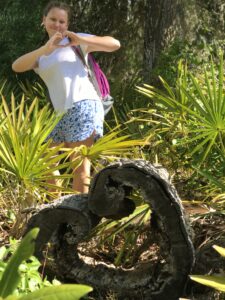
[Disclaimer: I am an employee of Celgene. The views reported here are my own.]
On a recent family vacation to Cumberland Island, a 9,800-acre barrier island off the coast of Georgia, I was mesmerized by the dense forest of live oak trees covered with Spanish moss. Upon first glance, the branches of these magnificent trees extend chaotically in all directions, and it is difficult to discern where the trees begin and end. But upon closer inspection, the root structure can be identified, moss disentangled, and the overall complexity unraveled.
These craggy oak trees serve as metaphor for our complex human biological ecosystem: a dense forest of molecules with gnarled branches of pathways meandering in all directions, without an obvious root structure of human disease. Extending the metaphor further, the oak trees make the point that I see as one of the most difficult aspect of drug discovery and development: understanding root cause of disease, and matching therapeutic modality and biological mechanism to prevent or cure devastating illness.
In this blog, I highlight two recent publications that underscore the importance of matching modality and mechanism. The first article, published in the New England Journal of Medicine, reported clinical data on 22 patients with beta-thalassemia treated with ex vivo gene therapy (here). The second study, published in Science Translational Medicine, describes an antisense oligonucleotide therapeutic intervention for Duchenne muscular dystrophy (DMD, see here). In both studies, human genetics serves as the source of “causal human biology”. I end the blog by describing other recent publications that provide insight into novel resources that should expand the molecular armamentarium for drug R&D.
Gene therapy for beta-thalassemia. The molecular defect for beta-thalassemia has been known since the late 1970’s (see OMIM entry here). Results from the first gene therapy clinical trial – defined here as ex vivo insertion of a normal hemoglobin subunit beta (HBB) gene into an individual’s own cells and then returned via autologous hematopoietic stem cell transplant – was reported to the FDA in 2009 (here) and published in 2010 (here). Only now, more than 40 years later, has a sufficiently powered clinical trial been conducted where therapeutic modality has been matched with the underlying molecular mechanism of action.
Beta-thalassemia patients were enrolled in two nonrandomized, open-label, single-dose phase 1/2 studies across seven sites. All beta-thalassemia patients were “transfusion dependent”, defined as having at least 8 transfusions per year for at least 2 years before enrollment. The gene therapy vector was a normal HBB gene introduced into a lentivirus construct under the control of a CMV promoter. Patients underwent myeloablative conditioning with intravenous busulfan before ex vivo engineered CD34+ stem cells (i.e., drug product) were re-introduced into patients. A video describing the protocol can be found here.
Clinical outcome varied by underlying HBB genotype (Table 1): 13 of 14 patients with a non–β0/β0 genotype stopped receiving red-cell transfusions, whereas only 2 of 8 patients with a β0/β0 genotype stopped receiving transfusions. Nonetheless, all patients requiring transfusions required a fewer number of transfusions post gene therapy (Figure 3). Four patients achieved a “normal” hemoglobin level of >12 g/dL at the last study visit.
There were other interesting pharmacodynamic readouts reported. For example, as shown in Figure 2, vector integration was determined to be randomly distributed across the genome without dominant clones (median number of unique integration sites was 1646 per patient). As shown in Figure 3, the vector copy number in the ex vivo engineered stem cells correlated with the vector copy number in patient’s peripheral blood, which in turn correlated with the production of vector-encoded beta-globin. Lastly, no replication-competent lentivirus was detected in the patients.
Thus, more than 40 years after the root cause of beta-thalassemia was discovered, a therapeutic modality has been matched with molecular mechanism, resulting in substantial clinical improvement in patients with a devastating disease.
Antisense oligonucleotide therapy for Duchenne muscular dystrophy (DMD). In contrast to the NEJM beta-thalassemia, the Phase 1 study in DMD patients does not report clinical efficacy (see Science Translational Medicine [STM] article here). Moreover, the molecular improvement in DMD is not as convincing it is for beta-thalassemia patients. Still, the STM study reinforces the challenge of matching modality with mechanism.
The gene for X-linked Duchenne muscular dystrophy (DMD) was discovered in late 1980’s (OMIM link here). Since that time, more than 2,000 different disease-causing mutations have been identified in the DMD gene (here). In some patients, the entire gene is deleted; in others, specific mutations result in loss of the gene product. For the latter, up to 80% of DMD mutations alter a specific exon that causes the protein product to be truncated.
Therapeutic interventions have not been very successful in DMD. While gene therapy has been attempted, it is difficult to get sufficiently high levels of expressed wild type protein in all of the muscle cells of the body. An alternative approach is to use antisense oligonucleotides (ASOs) to trick cells to produce functional DMD proteins that are only missing a mutated exon. Such therapeutic ASOs “skip” the mutated exon, thereby allowing a functional form of the DMD protein to be produced (albeit a protein that is missing an exon). One “exon skipping” ASO therapy has been approved, although not without controversy (here). Another ASO therapy was not approved (here).
The current STM study, which represents a third therapeutic ASO, describes a phase 1 clinical trial in 10 DMD patients. Patients had mutations in exon 53 of the DMD gene. In vitro assays were used to confirm that each of the 10 patient mutations were amenable to exon skipping with the therapeutic ASO, termed NS-065/NCNP-01. DMD patients were given one of three doses (1.25, 5 and 20 mg/kg) administered by drip intravenous infusion once a week for 12 weeks. Half-life of the drug in plasma was less than 2 hours. The primary clinical endpoints were safety and tolerability, and the pharmacodynamic endpoint was percent of DMD transcripts with exon 53 “skipped” in sliced frozen muscle normalized to plasma drug concentration (Figure 2).
The pharmacodynamics results were encouraging but modest: a dose-dependent increase in exon skipping was observed (Figure 2). However, only a single patient achieved an increase in exon 53 skipping by more than 10%. Intriguingly, this patient, NS-07, who received the highest dose and achieved the highest plasma concentration of NS-065/NCNP-01, demonstrated nearly 50% exon skipping as measured by RT-PCR from muscle. This individual also displayed dystrophin expression by Western blotting and immunofluorescence (Figure 3).
Thus, more than 30 years after the root cause of DMD was discovered, a therapeutic modality has been matched with molecular mechanism. Even still, the molecular correction with NS-065/NCNP-01 appears modest at best, and a larger study is required to determine if therapeutic intervention over longer periods of time translates into clinical benefits.
The key point for both articles: matching therapeutic modality with underlying molecular mechanism of action is one of the biggest challenges in drug discovery and development, especially for targets based on human genetics. Returning to the oak tree metaphor, a fundamental advance is untangling the chaotic limb structure of human biology and designing a therapeutic intervention that addresses the root cause of disease. Whether either of these studies lead to approved therapies for patients is another matter.
While these two examples highlight nucleic acid-based therapies, it is worth remembering that most modalities are more conventional (e.g., small molecule kinase inhibitors, blocking monoclonal antibodies, live or attenuated vaccines). But as I have commented before (here), such conventional modalities are likely to only drug ~10% of protein-coding targets. Thus, new modalities are needed, especially ones that match modality with mechanism.
On this last point, it is encouraging that new resources are emerging which will unlock the “undruggable” genome. For example:
– A recent study in Cell described the ordered structure of mRNAs from E. coli bacteria (here). As stated in the Discussion: “The most fundamental result of our study is that individual mRNAs have highly idiosyncratic architectures; in essence, each mRNA has its own distinctive structural ‘personality.’” Such ordered structure raises the possibility of drugging mRNAs directly with conventional small molecules, as described in this Biocentury news story.
– Derek Lowe blogged about DNA encoded libraries, which promise to expand the chemical space for small molecule libraries to billions (trillions!) of compounds (see here).
– Human genetics has uncovered links between microglia cells and neurodegenration, which has unleashed a wave of activity in therapeutic development (see Nature Reviews Drug Discovery News & Analysis here). But the problem of “matching modality and mechanism” is reinforced, as the current bottleneck is for researchers to unravel the biology of these complicated diseases.
– In 2014 the NIH launched an initiative, Illuminating the Druggable Genome (IDG), for the systematic collection and processing of a wide array of genomic, proteomic, chemical and disease-related data (see Nature Reviews Drug Discovery analysis here).
– The first-single cell atlas is now available via an online search database (see here).
Getting to the root cause – and matching modality with mechanism – is one of the greatest challenges faced in drug discovery and development. It takes perseverance in drug R&D, even more than it takes to do a perfect handstand. But the reward of navigating the path to arrive at the root structure of human disease is one that fills my heart with joy.


